Cycads
A combination of Cycads' slow-growing ways, deforestation of their habitats and the illegal plant trade has led to these ancient plants becoming the most endangered plant group on Earth.
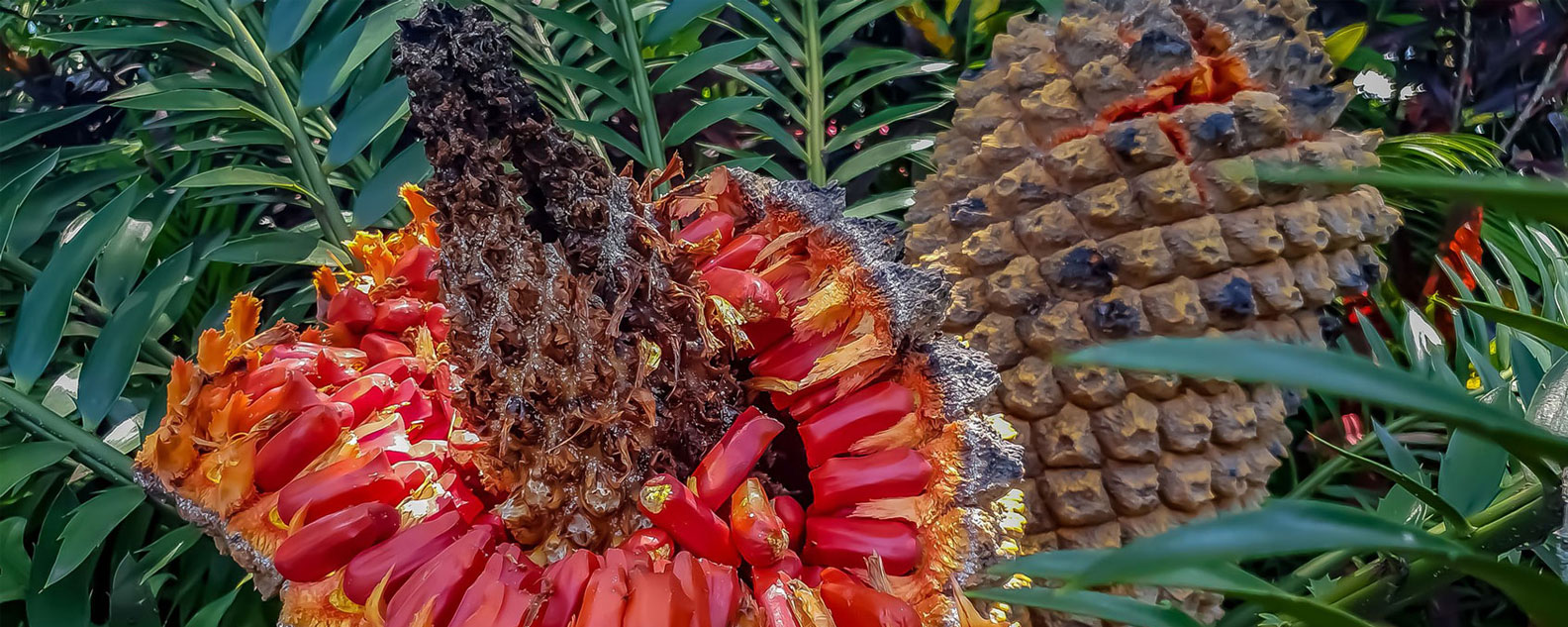
About the Cycadaceae family
Known as the Burrawang by the Dharug Peoples, Cycads are palm-like but they produce cones so they are grouped with conifers (known as gymnosperms, a group of non-flowering seed-producing plants with ancient roots from the Jurassic Period.
A Cycad does not produce flowers or fruit, it produces cones; has separate male and female plants – this is known as dioecious (separate male and female plants), and the seeds are toxic.
Over millions of years, the Cycad root system has adapted to host bacteria that absorb nitrogen from the air and transfer it to the plant, enabling the plants to survive in nutrient-deficient, sandy soils.
They have also adapted to conserve water, keeping their leaves' pores (stomata) sealed during the day in hot weather and opening them at night to absorb carbon dioxide.
No, Cycads are often mistaken for Palms, but Palms are angiosperms (from the Greek 'angeion' for 'vessel' and 'sperma' for 'seed'), a group of flowering and fruiting seed plants.
Having seeds that aren't encased in a flower isn't the only difference between Palms and Cycads:
Cycads have been around since Tyrannosaurus rex were roaming the Earth more than 150 million years ago. Palms are relative newcomers at 70-80 million years
Cycad leaves grow seasonally in a 'flush', sprouting simultaneously. Palms grow continuously.
Cycad trunks have a spiral pattern of leaf scars. Palms' scars form in stripes.
Most Cycads use a collaborative pollination mechanism known as mutualism. The starchy male cycad cones are the perfect home for tiny thrips and weevils, offering shelter and food. While the pollinators feast, they collect sticky pollen on their legs and bodies.
During the day, the male cones produce heat (known as thermogenesis) and foul-smelling chemicals, causing the tiny insects to decamp to female cones nearby. The pollen on their bodies pollinates the female cones, which can then develop fertile seeds.
Australia's native Burrawang (Dharug language) Cycads (Macrozamia communis and Lepidozamia peroffskyana), and the Pineapple zamia (Macrozamia lucida) all display mutualism.
Prehistoric megafauna dined on cycad seeds, carrying them hundreds of kilometres in their guts. This dispersed the seeds and created robust populations of genetically diverse plants; however, there are very few animals large enough to do that job today. One recent study showed that 70-100% of Cycad seeds travel less than a metre from their parent plant.
When Cycads are stolen from the wild, it's impossible to know where they came from, and as their populations shrink, their ability to adapt to climate change also diminishes.
Botanic Garden scientist Dr James Clugston is developing DNA fingerprinting technology to help monitor wild populations and develop new ways to protect them into the future. His work is part of a partnership between the University of Johannesburg, African Centre and the Australian Institute of Botanical Science.
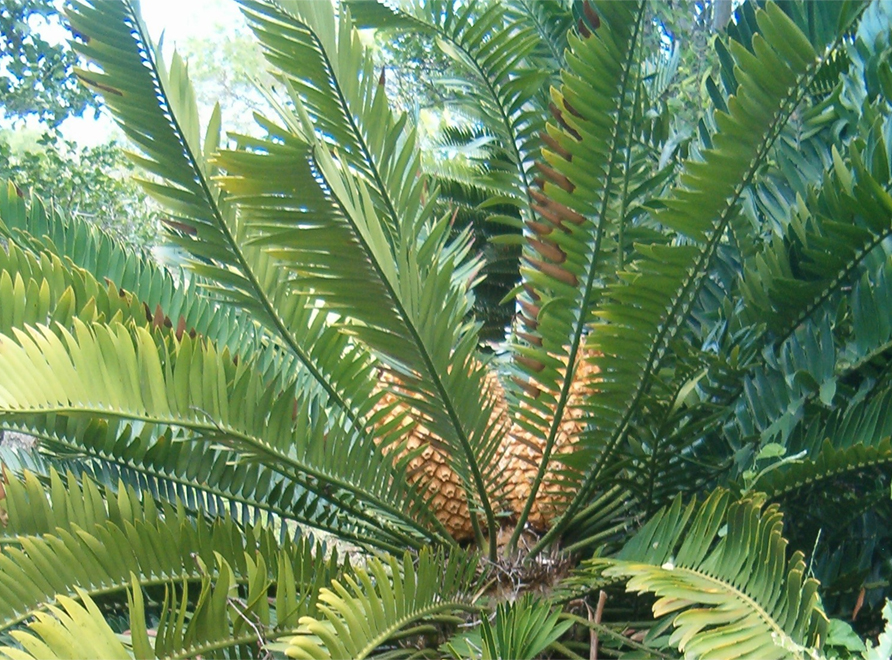
umGuza – Natal Cycad – Encephalartos natalensis
umGuza – Natal Cycad
umGuza – Natal Cycad – Encephalartos natalensis
Commonly known as the Natal Cycad, umGuza is this plant’s name in the Xhosa language of KwaZulu-Natal.
A member of the Zamiaceae family, the Natal Cycad is found in inland areas of KwaZulu-Natal in South Africa. If you're looking for a striking plant that's easy to grow in an outdoor pot or container garden, the Natal Cycad is an excellent option. They are endangered, so ensure that you purchase your plant from a reputable source.
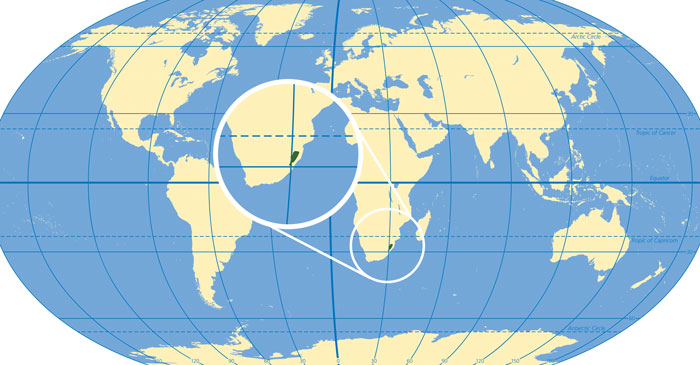
Natal Cycad's habitat
Natal Cycad
Natal Giant Cycad
Natal Broodbroom
Encephalartos is from the Greek 'en' meaning 'in', 'cephale' meaning 'head', and 'artos' meaning 'bread', which references the use of the plant's pithy stem as a bread flour by the First Nations peoples of KwaZulu-Natal in times of famine. The epithet 'natalensis' means 'from Natal', now KwaZulu-Natal.
Natal Cycads are frost-hardy and grow at altitudes of 1200 m on South Africa's inland cliffs, rocky outcrops, and evergreen forests. They are threatened by habitat destruction, illegal collection and poaching for the manufacture of herbal medicines in the wild.
Encephalartos natalensis is an evergreen, fast-growing, frost-hardy Cycad. It grows to 6.5 m high and sometimes has several trunks and basal suckers.
Its golden, woolly crown grows when it's producing cones or new whorls of leaves. The vibrant green leaves are from 1.5-3 m long. Its stiff, dark green leaflets are either spineless or have 1-5 teeth/spines, and the lower leaflets are reduced to spines on juvenile foliage.
Both the male and female Natal Cycads produce 2-3 cones. The male cones are cylindrical, yellowish-green and velvety. Growing up to 50 cm long, they shed their pollen from April to June.
The female cones are oblong to oblong-ovate, they grow up to 60cm long and their scales are wrinkled. The cones disintegrate from November to January, with each yielding about 500 bright red seeds that are poisonous to humans.
Visit the Garden Explorer and type 'Natal Cycad' into the 'Common or Scientific Name' field, then click search to be shown where it is located.
Garden Sign Story – Earth's most endangered
Once a cycad is stolen it’s almost impossible to discover where it was taken from. Wild populations are shrinking, and this damages their ability to adapt to challenges such as climate change.
DNA fingerprinting could link stolen plants back to their original location. Botanic Garden scientist Dr James Clugston is developing this technology, to help us monitor wild populations and develop new ways to protect them into the future.
Project partners: University of Johannesburg, African Centre; Australian Institute of Botanical Science.
Image: James Clugston in the lab.
Photo: S. Bedo
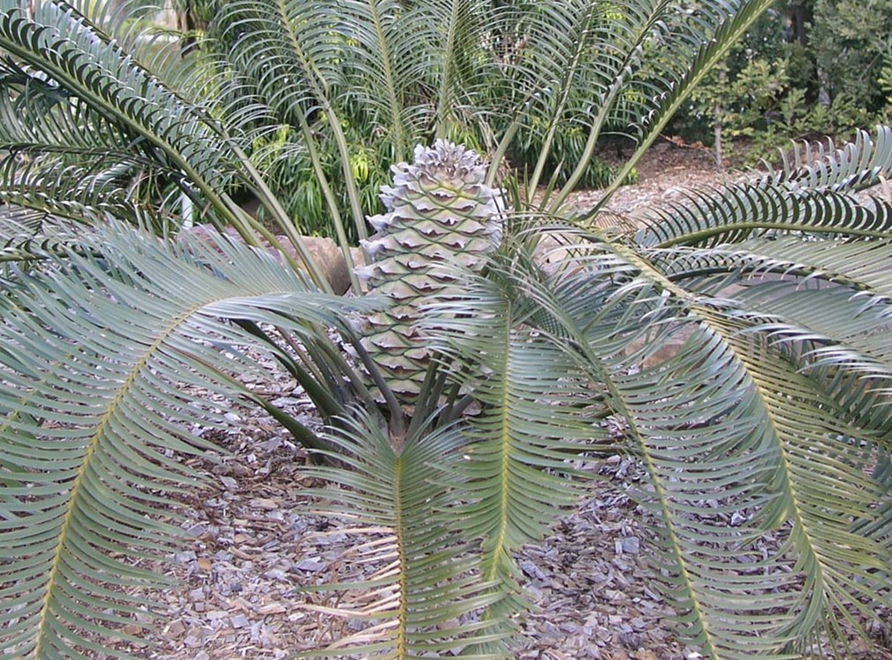
Pineapple zamia's habitat
Pineapple zamia
Pineapple zamia – Macrozamia lucida
The Pineapple Zamia is a slow-growing member of the genus Macrozamia and part of the Zamiaceae family. This Australian Cycad sports a crown of glossy leaves that can grow up to 1.5 m.
There are scattered populations of Pineapple Zamia in:
Queensland's Carnarvon Ranges
Hervey Bay
Nambour
the low ranges around Brisbane
the Border Ranges of northeastern New South Wales.
Although its large seeds are toxic, First Nations peoples knew how to leach the toxins, and they were an important source of bush tucker.
Pineapple zamia is an easy-care outdoor potted plant
If you’re looking for an Australian native that works well as a patio plant in pots or will look great in a rockery, the Pineapple zamia is just the ticket.
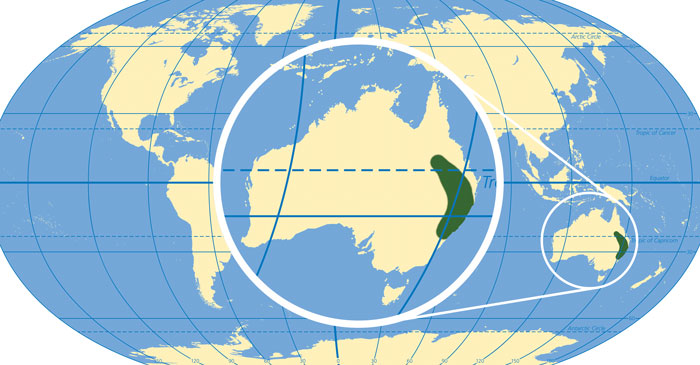
Pineapple zamia
The common name Pineapple zamia refers to the shape and colour of the cone. Macrozamia lucida's genus name is from the Greek 'Macro' meaning 'large', and 'zamia' is from 'azaniae' meaning 'pinecone'. The epithet 'lucida' is Latin for 'shining', a reference to the plant’s glossy leaflets.
Macrozamia lucida grows in coastal wet sclerophyll forests scattered from the Carnarvon Ranges in Queensland to the Border Ranges of New South Wales.
Unless it's an old specimen, Macrozamia lucida has an underground stem structure. The leaves in its crown grow up to 90 cm and each leaf has narrow, shiny, dark green leaflets.
Macrozamia lucida exhibits mutualism; its male cones produce pollen and are up to 15 cm long. Each seed compartment (sporophyll) contains spines.
The female cones grow to 15-20 cm long and the fruiting cones look like an elongated pineapple, with orange-red seeds that can be up to 4 cm long.
Visit the Garden Explorer and type 'Pineapple zamia' into the 'Common or Scientific Name' field, then click 'search' to be shown where they can be found in the Garden.
Garden Sign Story – A new generation of cycads is born!
Starchy male cycad cones make the perfect home for tiny thrips and weevils, offering shelter and food. While they feast, the insects collect sticky pollen on their legs and bodies.
Each day, the male cones heat up and produce foul-smelling chemicals. The tiny insects flee, landing on female cones nearby. The pollen on their bodies is transferred to the female cones, which can then develop fertile seeds. A new generation of cycads is born!
Image: With hairy legs, wings and bodies, thrips are well-equipped to transport microscopic grains of pollen.
Photo: D. Tree
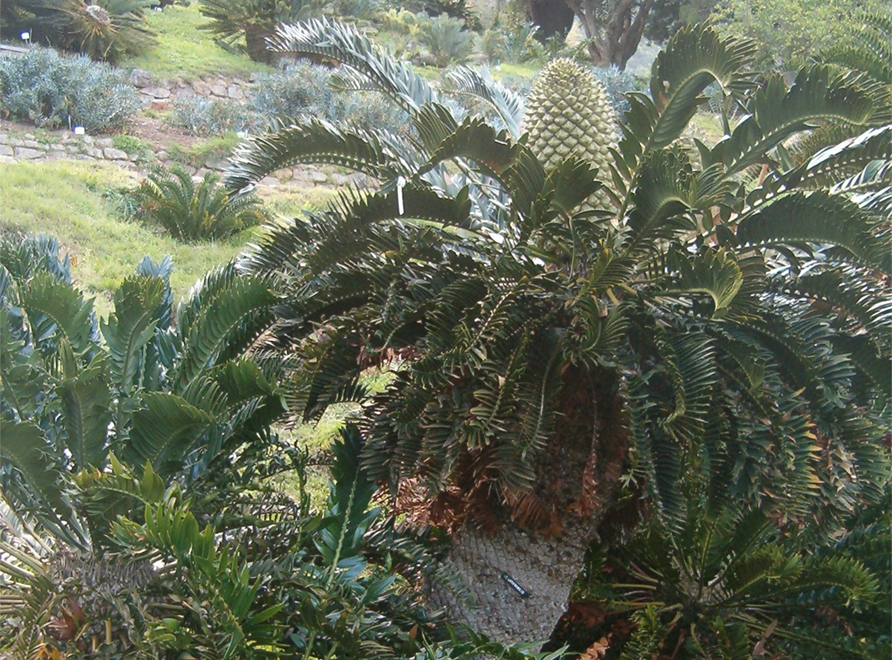
Albany Cycad
Albany Cycad
Albany Cycad – Encephalartos latifrons
The Albany Cycad is a rare and critically endangered South African cycad species, with less than 100 plants left in the wild. Land clearing and illegal collecting have contributed to its rarity and precarious situation.
It is a very slow-growing cycad which only exists in fragmented groups in the Bathurst and Albany districts of the Eastern Cape Province of South Africa. Botanic gardens' living collections are the only hope for this endangered species' survival.
First Nations uses of the Albany Cycad
The First Nations peoples of South Africa's Eastern Cape Province used the pithy stem of Encephalartos latifrons as bread flour.
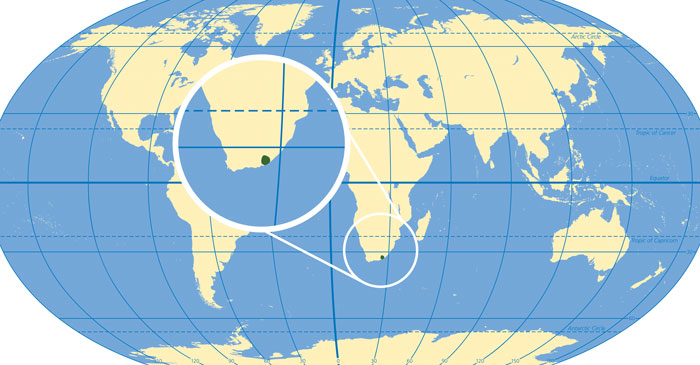
Albany Cycad's habitat
Encephalartos is from the Greek 'en' meaning 'in', 'cephale' meaning 'head', and 'artos' meaning 'bread', which references the stem’s use as a bread flour. The epithet latifrons is scientific Latin, meaning 'broad-fronded', describing the Albany Cycad's broad leaves.
A native of South Africa's Eastern Cape Province, the Albany Cycad grows on rocky outcrops and hills amongst scrub vegetation in areas that have hot, dry summers and no winter frost.
Encephalartos latifrons is an erect arborescent (tree-like) cycad species. Its trunk sometimes branches and suckers at the base, and its stems grow up to 3 m tall. The crown features long, stiff, arching leaves that have distinctive broad leaflets with two lobes at the tips.
The Albany Cycad produces 1-3 large, dark green cones on short, stout stalks every 17-years. The barrel-shaped female cones can be up to 60cm long, bearing large red seeds.
Visit the Garden Explorer and type 'Albany Cycad' into the 'Common or Scientific Name' field, then click search to be shown where it is located.
Botanic Gardens are the only hope for critically endangered plants
Botanic Gardens' living collections are the only way this species will survive. Less than 100 of these slow-growing plants are known in the wild, with no natural seed set or recruitment of seedlings.
Your donations help fund our scientists' crucial research. With your help, we can protect critically endangered plants like the ancient Albany Cycad. Make a Donation to the Botanic Gardens of Greater Sydney today.
Garden Sign Story – Death of the dispersers
Prehistoric megafauna munched on cycad seeds and carried them hundreds of kilometres in their gut. This created strong populations of genetically diverse plants.
Today, there are few animals large enough to do the job. One study showed that between 70-100% of seeds travelled less than a metre from their parent plant.
Image: Whole cycad seeds are preserved in fossilised poo of Jurassic megafauna, including the giant bird-hipped lizard Isoberrysaura mollensis.
Drawing: L. Attwell
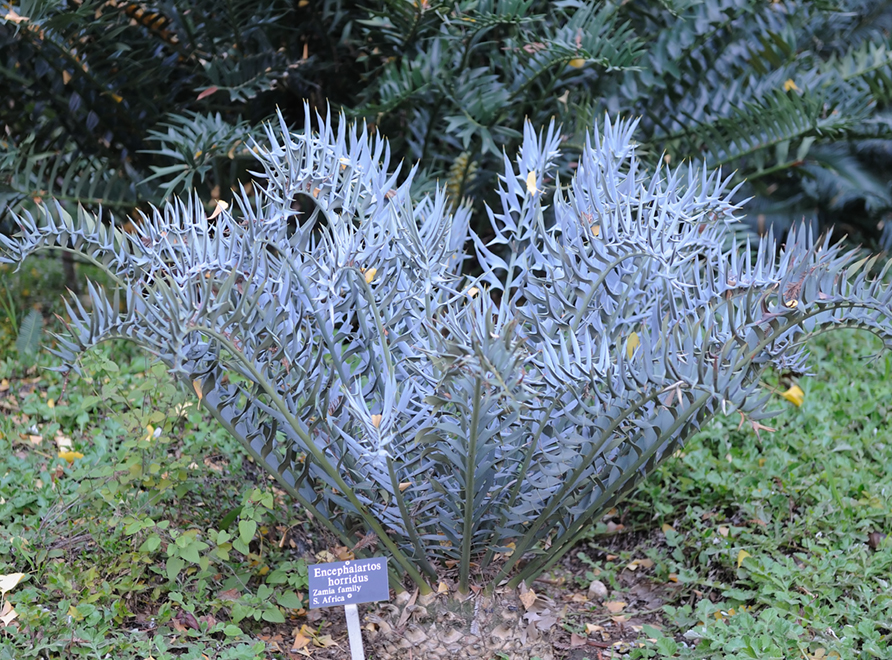
Eastern Cape Blue Cycad
Eastern Cape Blue Cycad
Eastern Cape Blue Cycad – Encephalartos horridus
Native to South Africa, the Eastern Cape Blue Cycad is a small, dense, slow-growing, highly ornamental cycad that clumps to 0.8m high. Like many Cycads, Encephalartos horridus is an endangered species on the IUCN Red List. However, it is grown and used extensively in landscaping, saving it from decline due to illegal collecting in the wild.
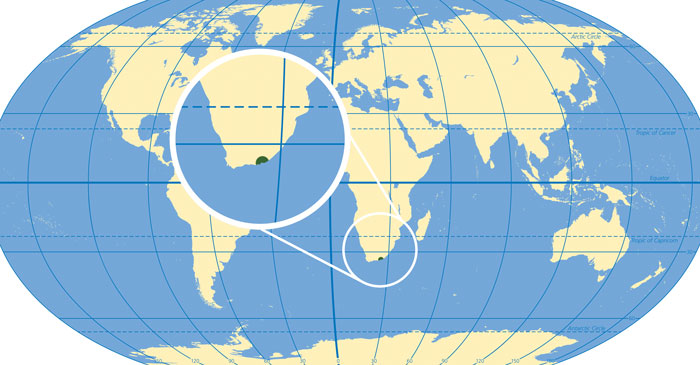
Eastern Cape Blue Cycad's habitat
Encephalartos is from the Greek 'en' meaning 'in', 'cephale' meaning 'head', and 'artos' meaning 'bread', which references the use of the plant's stem as a bread flour by First Nations Peoples of South Africa's Eastern Cape Province. The epithet 'horridus' appropriately means 'horrible' in Latin and refers to the plant's stiff, spiny leaflets.
Restricted to the Port Elizabeth and Uitenhage districts of Eastern Cape Province, E. horridus grows in full sun in arid, inland, thorny shrublands of Karoo scrub. It is commonly found on rocky quartzite ridges and slopes with shallow soils. The Eastern Cape Blue Cycad’s ideal climate is hot in summer and cool to mild in winter, with no frosts.
This cycad species has declined across broad areas of its former range due to habitat loss from expanding urban settlements and illegal collecting.
E. horridus is a low-growing cycad with distinctly coloured leaves; most of the stem (the caudex) grows below ground. The stiff, spiny leaves in the crown grow to 1 m long, they are silvery-blue when young but turn green with age.
There are two wild forms of Encephalartos horridus, a dwarf and a larger, more robust, typical form.
Although E. horridus bears a single cone per crown, male plants occasionally have two cones from December to January. Mature cones are bluish-green and the female cone is egg-shaped. The seeds are pale to deep red and roughly triangular.
E. horridus displays mutualism, a form of pollination vital to Cycads' continued survival. The seed is dispersed by birds and animals that eat the fleshy outer and discard the toxic seed, which germinates where it falls. It can also reproduce through suckers that grow from the parent plant.
Visit the Garden Explorer and type 'Eastern Cape Blue Cycad' into the 'Common or Scientific Name' field, then click search to be shown where it is located.
Garden Sign Story – Survival stunts
Look down – the mass of coral-like (coralloid) roots is specially adapted to host bacteria. The bacteria absorb nitrogen from the air and transfer it to the plant – this means cycads can grow happily in nutrient-poor sandy soils. In exchange, the bacteria absorb the carbon they need from the plant.
Image: The blue ring inside the collaroid root is Cyanobacteria.
Photo: J. Clugston
Cycads have another trick to conserve water when it’s hot. By changing how they photosynthesise energy, their stomata – leaf-pores – stay sealed during the day’s heat, only opening at night to absorb carbon dioxide.
Image: A microscopic view of stomata on the leaf surface of Cycas revoluta.
Photo: V. Krassilov, Plant 2013 a
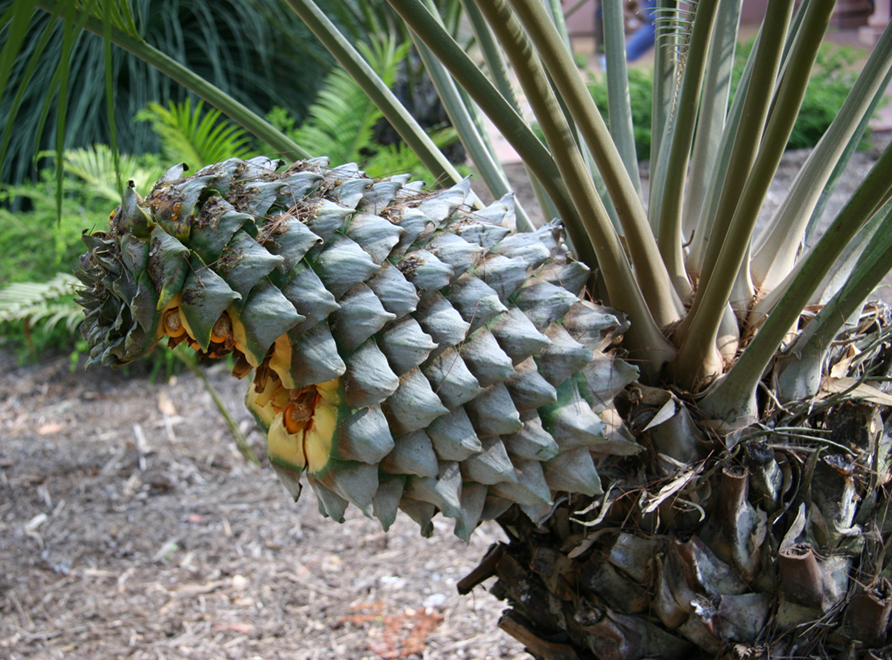
Scaly Zamia – Burrawang
Scaly Zamia
Scaly Zamia – Burrawang (Dharug language) – Lepidozamia peroffskyana
Growing in Coastal areas of northern New South Wales from the Manning River to Gympie, Queensland, the Burrawang plant is one of only two Australian Zamia Cycads growing to 7m tall.
Bring some drama to the patio!
If you're looking for ideas for your patio garden, why not try an Australian native plant? The Burrawang is easy to grow in pots, and its vibrant seeds and foliage will bring some drama to the patio.
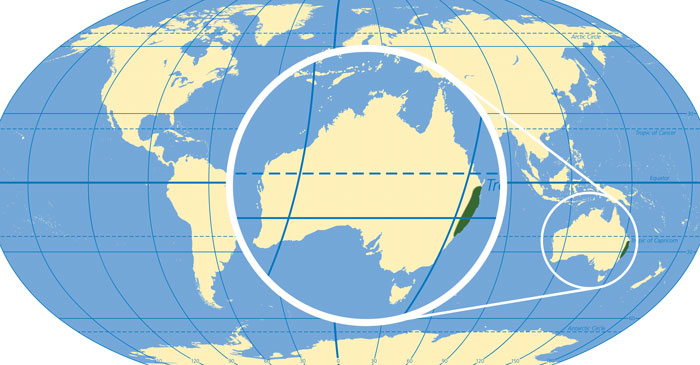
Scaly Zamia – Burrawang's habitat
The barrel-shaped female cones are grey-green, can grow as large as 80 cm long and 25 cm wide, and can weigh up to 30 kg. The cones break apart when they're ripe to release 5 cm oblong, bright red seeds.
Male cones are about 60 cm long and 12 cm wide, cylindrical and curved. They shed pollen by opening in a spiral and distending up to 1 m in length.
Like many Australian Cycads, the Burrawang has a mutualistic relationship with a host-specific species of weevil.
'Lepidos' is from the Greek for 'scale', and 'zamia' is Latin for 'pine-nut'.
The epithet peroffskyana was given to the plant to honour Count V.A. Peroffsky, the 19th-century benefactor of St. Petersburg Botanical Garden, where the type specimen was cultivated.
Burrawang grows wild on the New South Wales coast, north of the Manning River up to Gympie in Queensland. It grows on slopes sometimes bordering rainforests at elevations from sea level up to 1000 m. It is found in dense stands in wet, open, sclerophyll forests where fire is uncommon to rare.
Burrawang – Lepidozamia peroffskyana is a tall, palm-like Cycad that occasionally grows to 7 m, some ancient plants are multi-trunked.
Up to 50-60 very glossy, dark green leaves rise from a central crown and can grow up to 3 metres in length, arching with age. New leaves are bronze, appearing in flushes that rise vertically with furled leaflets. L. peroffskyana's leaflets rise alternately from the midline of the leaf-spine (rachis), differing from other Macrozamia species, which rise or extend laterally from the edges of the rachis.
Burrawang is dioecious, and the female cone produces huge red seeds that contain toxic compounds. First Nations peoples have worked out how to leach out the toxins and it has always been a vital bush tucker plant.
Burrawang has adapted to bushfires by producing cones before the emergence of new fronds following a fire.
Visit the Garden Explorer and type 'Scaly Zamia' into the 'Common or Scientific Name' field, then click search to be shown where it is located.
Visit the Garden Explorer and type 'Scaly Zamia' into the 'Common or Scientific Name' field, then click search to be shown where it is located.
Garden Sign Story – Mistaken identity
Leaves: Cycads’ leaves emerge in a ‘flush’ each season – a whole set of new leaves growing at once. Palms tend to grow continuously, sprouting new leaves one at a time.
Flowers or cones? Cycads have cones. They are related to conifers (gymnosperms) – plants with ‘naked seeds’. Palms have flowers and fruit.
Trunk scars: Cycads have a spiral pattern of leaf scars on their trunks. Palms have scars that wrap their trunk in stripes.
Illustrations: C. Wardrop
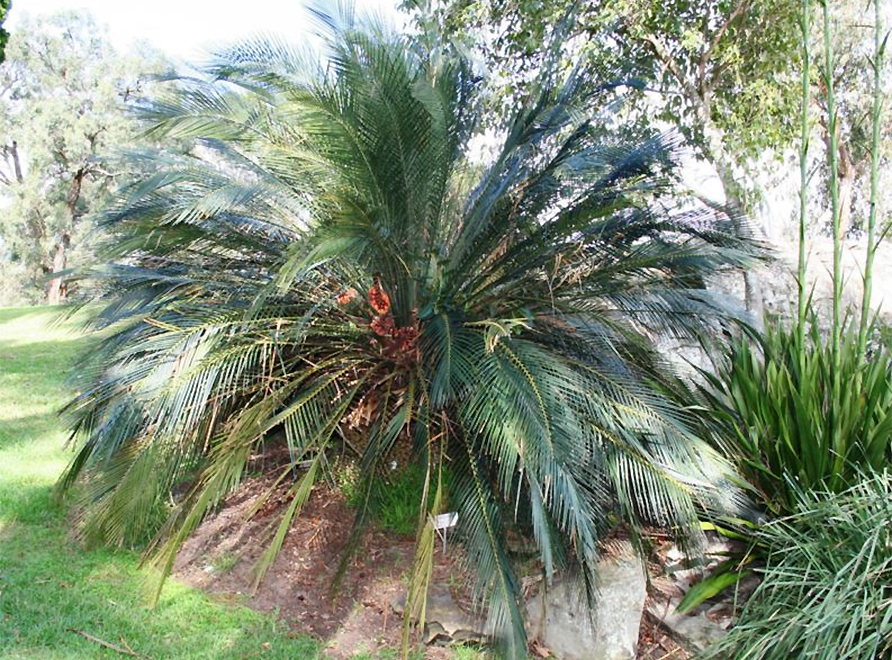
Burrawang (Dharug language)
Burrawang (Dharug language)
Burrawang (Dharug language) – Macrozamia communis
Macrozamia communis is a medium-sized palm-like plant with large, pinnate leaves rising from a crown on a short or underground trunk.
Meet one of the world's most southern Cycads
Not only is Macrozamia communis the most common and widespread Cycad in New South Wales, but it's also one of the most southerly occurring Cycad species in the world. You'll find it growing wild in coastal districts from Kempsey to Bega and adjacent ranges, as well as inland as far as Mudgee.
On the New South Wales South Coast, it's common to see Macrozamia communis form the understory to Spotted Gums (Corymbia maculata).
A bush tucker plant to be handled with care
Burrawang's starchy seeds are an important part of the bush tucker diet, but they're poisonous if they aren't appropriately prepared.
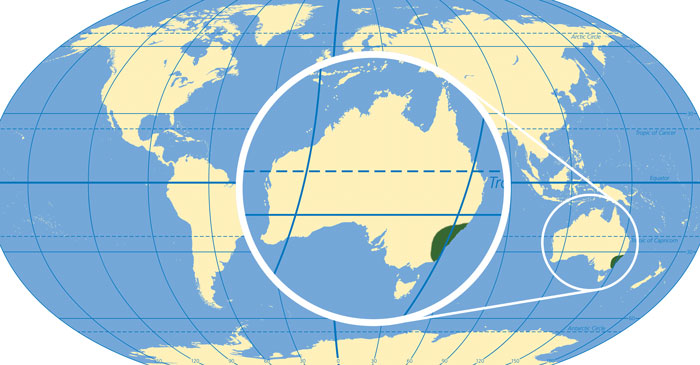
Burrawang's habitat
If you're looking for potted plant inspiration, you can't go past Burrawang. It grows well in pots and containers, and its vibrant red seeds and glossy foliage will bring vibrant colour to your garden.
Macrozamia communis’ genus name combines 'Macro', the Greek for 'large' and 'zamia', a derivative from the Greek 'azaniae' for ‘pinecone'. 'Communis' is from Latin meaning 'communities', referring to the fact that this cycad species is often found in dense stands.
Macrozamia communis is found in sclerophyll forest on sandy to loamy soils, often in dense stands and is sometimes very abundant in open eucalypt forest. It grows in New South Wales’ coastal districts from Kempsey to Bega, the adjacent ranges, and inland as far as Mudgee.
The stem of M. communis can be wholly underground, or it may form a 1-2 m high woody trunk up to 80 cm wide in shallow soils.
This Macrozamia Cycad's elegant leaves are 1-2 m long with up to 100 glossy green leaflets in the crown. Individual specimens take 10-20 years to mature and they may live for up to 120 years.
Male and female M. communis seed cones form after a fire, and the large red female seeds contain toxic compounds which have caused fatalities to both humans and livestock.
Like all Cycads, M. communis is dioecious. The male cones are cylindrical up to 45 cm long by 15 cm wide, ageing to a greyish-brown colour. Female cones are barrel-shaped to about 45 cm x 20 cm. When ripe, the cone on the female plant breaks apart to release bright red 5 cm seeds.
Macrozamia Cycads have a mutualistic relationship with the Tranes weevil (Tranes spp.), which pollinates the female cones.
Visit the Garden Explorer and type 'Macrozamia communis' into the 'Common or Scientific Name' field, then click search to be shown where it is located.
Visit the Garden Explorer and type 'Macrozamia communis' into the 'Common or Scientific Name' field, then click search to be shown where it is located.
Garden Sign Story – A lethal bite
Cycad seeds are toxic, but First Nations peoples used a complex process to render them edible. Several of Captain Cook’s Endeavour crew described the effects of eating unprocessed cycad seeds:
‘… our people… were violently affected by them both upwards and downwards… and our hogs… dyed after having eat them.’
Beaglehole (after J. Banks, 1770)
Image: Seeds of the Burrawang